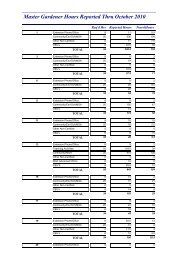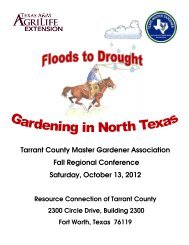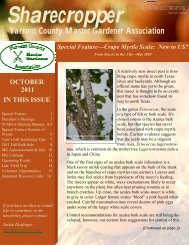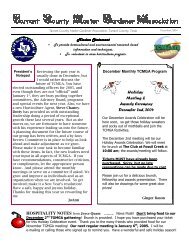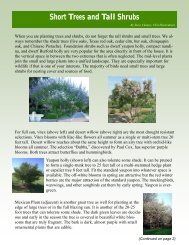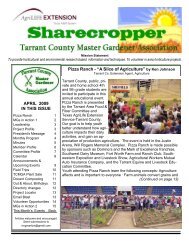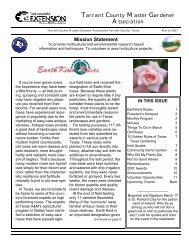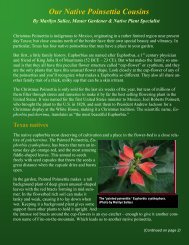december 2010 issue - Tarrant County Master Gardener Association
december 2010 issue - Tarrant County Master Gardener Association
december 2010 issue - Tarrant County Master Gardener Association
You also want an ePaper? Increase the reach of your titles
YUMPU automatically turns print PDFs into web optimized ePapers that Google loves.
Sharecropper Page 7<br />
Trees Provide Substance for Garden Landscaping (cont’d)<br />
The selection of those trees that are super<br />
easy to grow and enjoy is outstanding, even<br />
here in North Texas. Whether you choose tall<br />
or short, evergreen or deciduous, flowers or<br />
foliage, spring blooms or fall colors, there<br />
are kinds – and varieties within each kind –<br />
to suit nearly every need and season.<br />
It’s an oddball fact, but a smaller tree will<br />
outgrow a larger tree of<br />
the same species, if<br />
planted concurrently,<br />
nearly every time. This<br />
is simply because the<br />
smaller tree has a<br />
higher percentage of<br />
roots versus top, so it<br />
doesn’t waste time<br />
playing catch-up as does the larger tree<br />
which spends months and sometimes years<br />
just setting there barely alive while it builds<br />
its root system to accommodate the larger<br />
amount of branches and foliage. Choosing a<br />
tree that is smaller can be important both for<br />
your wallet and your back, and it will help<br />
determine how quickly the tree will get established<br />
and begin actively growing.<br />
Even if you plant small specimens, keep in<br />
mind that trees need elbow room to grow.<br />
Small ones can fill a void beneath other larger<br />
trees with their spreading branches and<br />
roots. It is best to include only very small species<br />
in new flowerbeds, and then wait until larger<br />
trees are more established before planting<br />
shade perennials and ground covers underneath.<br />
Meanwhile, nothing beats a clean layer of natural<br />
mulch to make new trees “look right”, while<br />
protecting the new roots from hot summer days,<br />
cold winter nights as well as attacks from lawn<br />
mowers and string trimmers. Plus, as leaves and<br />
bark decompose, they feed the soil around the<br />
tree roots in a most natural way (after all, it’s<br />
how Mother Nature planned for things to work<br />
in the forest for a long, long time)!



